
The Rubiaceae are a family of flowering plants, commonly known as the coffee, madder, or bedstraw family. It consists of terrestrial trees, shrubs, lianas, or herbs that are recognizable by simple, opposite leaves with interpetiolar stipules and sympetalous actinomorphic flowers. The family contains about 13,500 species in about 620 genera, which makes it the fourth-largest angiosperm family. Rubiaceae has a cosmopolitan distribution; however, the largest species diversity is concentrated in the tropics and subtropics. Economically important species include Coffea, the source of coffee, Cinchona, the source of the antimalarial alkaloid quinine, some dye plants, and ornamental cultivars.
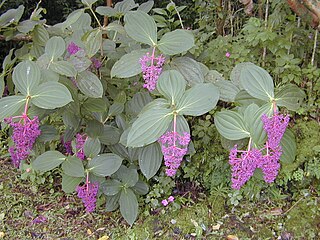
Medinilla is a genus of about 193 species of flowering plants in the family Melastomataceae, native to tropical regions of the Old World from Africa east through Madagascar and southern Asia to the western Pacific Ocean islands. The genus was named after J. de Medinilla, governor of the Mariana Islands in 1820.

Moduza procris, the commander, sometimes included in the genus Limenitis, is a medium-sized, strikingly coloured brush-footed butterfly found in South Asia and Southeast Asia. It is notable for the mode of concealment employed by its caterpillar and the cryptic camouflage of its pupa.
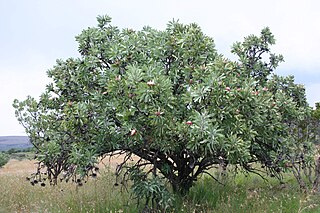
Protea caffra, native to South Africa, is a small tree or shrub which occurs in open or wooded grassland, usually on rocky ridges. Its leaves are leathery and hairless. The flower head is solitary or in clusters of 3 or 4 with the involucral bracts a pale red, pink or cream colour. The fruit is a densely hairy nut. The species is highly variable and has several subspecies.
Eugenia erythrophylla is a species of plant in the family Myrtaceae. It is endemic to South Africa. It is threatened by habitat loss.

Protea aristata is a compact shrub with beautiful flowers which is endemic to the southwestern part of the Cape Region of South Africa. P. aristata has become one of South Africa's most famous proteas in spite of its relatively late discovery, and re-discovery in 1953. The leaves are soft, dense and needle-like and the flower heads are a stunning crimson red, it may thus be a good potential ornamental plant for South African gardens. It is usually called the Ladismith sugarbush in South African English, although it has been called pine sugar bush in Australia. In the Afrikaans language it has the vernacular name of klein-den-suikerbos.

The National Botanic Garden of Bangladesh and the Bangladesh National Herbarium make up the largest plant conservation center in Bangladesh, with an area of around 84 hectares. It is located at Mirpur in Dhaka, beside the Dhaka Zoo. It was established in 1961. It is one of the greatest botanic gardens of Bangladesh, a knowledge center for nature lovers and botanists and a tourist destination. The herbarium has a scientific collection of approximately 100,000 preserved specimens of plants.
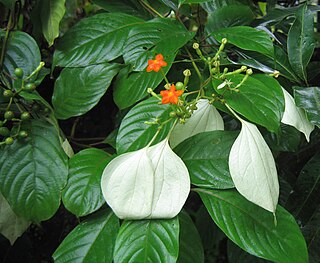
Mussaenda is a genus of flowering plants in the family Rubiaceae. They are native to the African and Asian tropics and subtropics. Several species are cultivated as ornamental plants.
Pteroteinon concaenira, the narrow-banded red-eye, is a butterfly in the family Hesperiidae. It is found in Ivory Coast, Ghana, Nigeria, Cameroon, the Republic of the Congo, the Central African Republic, the Democratic Republic of the Congo, western Uganda, north-western Tanzania and north-western Zambia. The habitat consists of forests.

Mussaenda macrophylla, commonly known as sweet root is an evergreen Asian shrub. The bracts of the shrub may have different shades, including red, white or some mixtures. M. macrophylla is native to Asian countries like China, Taiwan, Nepal, Myanmar, Malaysia, Philippines.
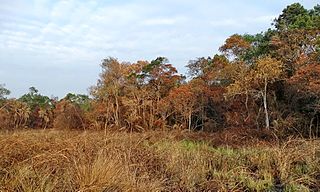
The Minziro (Nature) Forest Reserve is a 24,841 ha conservation area along the Kagera River in Bukoba district of northwestern Tanzania. It protects one of the largest forests in Tanzania, of a forest type that is unique in the country. It was gazetted in 1947 and is situated at around 1,150 metres a.s.l. in fairly level terrain. The forest is continuous with the Malabigambo Forest over the nearby Uganda border. The largest part consists of Baikiaea–Podocarpus seasonal swamp forests while the remainder is flooded acacia woodlands.

Mussaenda frondosa, the wild mussaenda or dhobi tree, is a plant of family Rubiaceae. It is a shrub that grows to about 1.5–2 m tall. Like all other Mussaenda species, they have a large prominent white petaloid sepal in their flowers.

Mussaendeae is a tribe of flowering plants in the family Rubiaceae and contains about 221 species in 8 genera. Its representatives are found from tropical and southern Africa, the western Indian Ocean, to tropical and subtropical Asia and the Pacific region.
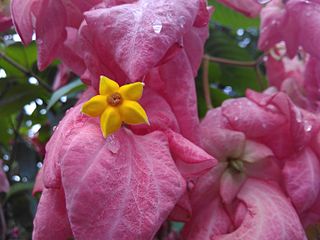
Mussaenda philippica is a plant species in the family Rubiaceae that grows as a shrub or small tree. Native to the Philippines it is commonly grown elsewhere as an ornamental species. Known varieties include: "Donna Laz" (pink), "Alicia Luz", "Queen Sirikit", "Donna Aurora" (white), and "Donna Envangellina".

Protea magnifica, commonly known as the queen protea, is a shrub, which belongs to the genus Protea within the family Proteaceae, and which is native to South Africa.
The Latin word frondosa is the species name of many unrelated fungi, plants, and animals that have a frondose shape.
Protea intonsa, also known as the tufted sugarbush, is a flowering plant of the genus Protea within the family Proteaceae, endemic to South Africa, where it is distributed from the eastern Swartberg and Kammanassie Mountains to the Baviaanskloof mountains. In Afrikaans it is known as klossie-suikerbos.

Protea stokoei is a flowering shrub which belongs to the genus Protea. The plant is endemic to South Africa. It is found in the Kogelberg and Greenland mountains around Elgin.

Protea grandiceps, commonly known as rooisuikerbos, suikerbos or red sugarbush, is a flowering shrub that belongs to the Protea genus and is native to parts south western parts of South Africa. The shrub was listed as an+ near threatened species in 2006 according to the South African National Biodiversity Institute.
Protea witzenbergiana, or Swan sugarbush, is a flowering shrub of the genus Protea.
















